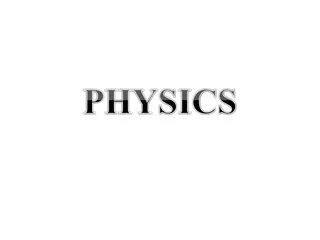Understanding Moments and Forces in Physics
Explore the concepts of balanced forces, levers, pivots, and moments in physics through practical experimentation. Dive into the principles behind levers, moments, and unbalanced systems while learning about weight versus mass and calculating moments in various scenarios.
Download Presentation

Please find below an Image/Link to download the presentation.
The content on the website is provided AS IS for your information and personal use only. It may not be sold, licensed, or shared on other websites without obtaining consent from the author. Download presentation by click this link. If you encounter any issues during the download, it is possible that the publisher has removed the file from their server.
E N D
Presentation Transcript
Levers pivot
Write out the statements that are true. a The longer the lever, the bigger the force that is needed to move an object. b It is easier to close a door if you push the door close to the hinge c The shorter the lever, the bigger the force that is needed to move an object d Joints are examples of pivots. e Bones are examples of levers.
Learning Objective To investigate, through practical experimentation, the principle of moments.
Recording your results What do we need to record? How many columns will we need in our table?
Recording your results Recording your results
Weight and Mass YouTube - Eureka! Episode 6 - Gravity YouTube - Eureka! Episode 7 - Weight vs. Mass Racing Balls
Write out each term along with its correct description unbalanced system Descriptions anticlockwise moments = clockwise moments two boys of different weights sit opposite each other on a see saw, both the same distance from the pivot the turning effect of a force Lever Principle GCSE PHYSICS: Moments
Moment calculation Gina weighs 500N and stands on one end of a seesaw. She is 0.5m from the pivot. What moment does she exert? moment = 500 x 0.5 = 250 Nm 0.5m 500N pivot
Moment equation The moment of a force is given by the equation: moment = force (N) x distance from pivot (cm or m) moment f x d Moments are measured in Newton centimetres (Ncm) or Newton metres (Nm).
Principle of moments The girl on the left exerts an anti-clockwise moment, which equals... her weight x her distance from pivot The girl on the right exerts a clockwise moment, which equals... her weight x her distance from pivot
Principle of moments If the anticlockwise moment and clockwise moment are equal then the see-saw is balanced. This is known as the principle of moments. When something is balanced about a pivot: total clockwise moment = total anticlockwise moment
Principle of moments calculation Two girls are sitting on opposite sides of on a see-saw. One girl weighs 200N and is 1.5m from the pivot. Where must her 150N friend sit if the seesaw is to balance? When the see-saw is balanced: total clockwise moment = total anticlockwise moment 200N x 1.5m = 150N x distance 200 x 1.5 = distance 150 distance of second girl = 2m
Why dont cranes fall over? Tower cranes are essential at any major construction site. trolley load arm counterweight loading platform tower Concrete counterweights are fitted to the crane s short arm. Why are these needed for lifting heavy loads?
Why dont cranes fall over? Using the principle of moments, when is the crane balanced? 3m 6m ? 10,000N moment of = moment of load counterweight If a 10,000N counterweight is three metres from the tower, what weight can be lifted when the loading platform is six metres from the tower?
Why dont cranes fall over? moment of load load x distance of load from tower = = ? x 6 counterweight x moment of counterweight distance of counterweight from tower = = 10,000 x 3 = 30,000 Nm moment of load = moment of counterweight ? x 6 = 30,000 ? = 3,000 6 ?= 5,000 N
Crane operator activity Where should the loading platform be on the loading arm to carry each load safely?























